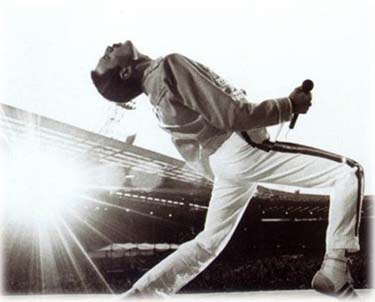« July 2009 |
Main
| September 2009 »
 August 27, 2009 | Respect the Silence
August 27, 2009 | Respect the Silence
From ClassicalNotes.net, Peter Gutmann on John Cage and the Avant Guarde "The Sounds of Silence:"
"4'33" was Cage's favorite work. Written in 1952, it came at the exact mid-point of his 80-year life of discovery and culminated his exploration of indeterminacy, music in which some elements are carefully scripted with others left to chance. The year before, he had written his Imaginary Landscape #4 for 24 performers, each of whom adjusted the volume or tuning of one of a dozen radios; although the dial settings were exactly prescribed, the result depended upon the frequencies and formats of local stations. 4'33" was inspired by Cage's visit to Harvard's anechoic chamber, designed to eliminate all sound; but instead of promised silence Cage was amazed and delighted to hear the pulsing of his blood and the whistling of his nerves.
 Most music is trivialized by attempts to describe it. ("The melody is announced by the flutes...") That's not a problem with 4'33". Here's how one performance went: A tuxedoed performer came on stage, sat at a grand piano, opened the lid, occasionally turned some music pages but otherwise sat as quietly as possible for 4 minutes and 33 seconds, then rose, bowed and left. And that was it. Most music is trivialized by attempts to describe it. ("The melody is announced by the flutes...") That's not a problem with 4'33". Here's how one performance went: A tuxedoed performer came on stage, sat at a grand piano, opened the lid, occasionally turned some music pages but otherwise sat as quietly as possible for 4 minutes and 33 seconds, then rose, bowed and left. And that was it.
Although often described as a silent piece, 4'33" isn't silent at all. While the performer makes as little sound as possible, Cage breaks traditional boundaries by shifting attention from the stage to the audience and even beyond the concert hall. You soon become aware of a huge amount of sound, ranging from the mundane to the profound, from the expected to the surprising, from the intimate to the cosmic--shifting in seats, riffling programs to see what in the world is going on, breathing, the air conditioning, a creaking door, passing traffic, an airplane, ringing in your ears, a recaptured memory. This is a deeply personal music, which each witness creates to his/her own reactions to life. Concerts and records standardize our responses, but no two people will ever hear 4'33" the same way. It's the ultimate sing-along: the audience (and the world) becomes the performer.
Let's tackle a few obvious questions. Is this music? Sure it is - each sound has a distinct tone, duration, rhythm and timbre. Isn't it arbitrary? But so are all artistic conventions. Couldn't a 3-year old have written this piece? Perhaps. But did he? Did you?"
This was quite a historic moment in the development and definition of contemporary music, and not one that can ever be duplicated. What does it have to do with your playing? Let's use it to make a point about silence, or better, "musical space." As ensemble players, we often go out of our way to fill each performance moment with something musically interesting. Ever play with a lead guitar player who insisted on noodling the whole time, playing asymmetrically parallel to the melody? How about playing with a bass player that thinks he's Geddy Lee incarnate, and abandons the role of driving the band for distracting upper fret exploration? You might have played with a drummer the rest of the band nickname "Fill," because he feels punctuating the end of EVERY phrase is his enduring entitlement.
There is little more musicially satisfying than playing in an ensemble devoted to a healthy respect for sonic space. The goal should always be to make the other individual players of the group sound good, and there is no way to accomplish this without adequate silence. It can be as radical as sitting out a chorus or two, or as simple as just not playing through every turnaround. Trading time in the limelight gives the audience a dose of textural "freshening," and it makes players listen sensitively to each other. Interesting things happen during this silence, and we aren't talking about the peripherals of air condition, crowd conversations, or creaking doors mentioned in John Cage's 4'33". It's the impact on the music itself that is so remarkable when that breathing room between musicians is developed.
Does this problem plague your band? Challenge the other members by interrupting during practice and quizzing each other who is playing what. Stop and ask your piano player what's going on in the kick drum, or ask the guitar player what's happening in the right hand of the keyboardist. Simply disciplining yourselves to pay attention to these small details can make your ensemble sound better than ever.
Be the "Silence."
Further:
Plays Well With Others...
Ensemble Sensitivity: Corps playing
Playing with a drummer
Building off silence
Posted by Ted at 5:59 AM
 August 20, 2009 | Complements of you...
August 20, 2009 | Complements of you...
First reaction for the astute would be we've misspelled the title, but bear with us as we explain.
If you're a sports fan of any kind, you've probably been to a stadium or gym where the audience was treated to the communal "Stomp stomp, CLAP! Stomp stomp, CLAP!" The crowd reaction is primal, the next response you hear after the rhythmic groove settles in are the lyrics from the chorus, "We will, we will, ROCK you!" Primal? Yes. Aboriginal? Arguably, but the effect is almost universal, the invitation to join in is compulsive.
It's the simplest elements of rhythm and melody that offer this kind of broad appeal, and there is nothing wrong with settling in to this approach to grab your audience. It's a big consideration when you work within an ensemble, how the sum of the experience can remain satisfyingly simple, and still offer more complex nuance outside of this framework.

A good example of this is taking the impact of that stirringly popular "Queen" song into your own strategy of complementing the other players. If you work with a drummer, the driving "CLAP" part of this is in the snare drum. The question becomes what can a mandolin do to complement that backbeat? Consider the "Stomp, stomp." part of the groove. In other words, your "1 and... 3 and..." stomps work in tandem with the snare's CLAP!
Generally, working with a drummer, we try to lock in and reinforce the backbeat, but embrace the occasional opportunity to "complete." Maybe it's the bass player you want to complement, and electric guitar riff, or another percussion instrument. Just don't fall in the very common trap of being yet another strumming "guitar."
Assure your audience that "We will, we will, rock you!"
Further:
Opening Opportunity in Accompaniment Mandolin
What's a mandolin sound like?
Mandolin in Context
Plays Well With Others...
Posted by Ted at 9:01 AM
 August 13, 2009 | Chords in the fingers. Chords in the head.
August 13, 2009 | Chords in the fingers. Chords in the head.
Think of how these chords are learned. Finger goes here, finger goes there. Strum. Shift, repeat. Pattern. Pattern. Pattern, etc.
It's all very tactile, a physical process. Sure you might learn how a G7 relates (leads) to a C Major chord, or you might actually think of the individual members of this chord are, but basically, you're just thinking fingering block, fingering block, fingering block, as you shift from one to the next. These are "chords in the fingers."

The more advanced music theory enthusiast will have a slightly different, intellectual perspective of what a chord is. This person will have a cerebral awareness of all the actual members of the chord, each tone will have both a functional and relational significance. He/she will be aware of all these notes whether they are fingered or not. This person will have an edge in many ways:
Chord inversion/substitution. Knowing the makeup of a chord allows you to invent your own favorite chords. Sure you can buy a good chord encyclopedia, but if you want good voice leading from chord to chord, this is the most effective way to bridge one to a more efficient voicing. Harboring an extensive internal chord library isn't as big a deal when you know a little theory. Moving blocks of chords or "grips" cuts the complexity of learning hundreds, if not thousands of individual chords.
Chord movement. It sounds jerky, and it looks awful to see someone perpetually jump from one end of the fretboard to the other, simply because they have never learned a good chord vocabulary. You should never have to move more than 3 or 4 frets from any note to the next, not only because of speed, but good voice leading, aurally and kinetically.
Harmonic implication and intent. We preach about this all the time. Matter of fact, our most recent MandoinSessions article explores this and offers a way of working with a diatonic chord progression and shows how you can voice these chords horizontally rather than vertically through arpeggios. Check out Spelling out the Chords. Melodically. It's important that you communicate the chord pattern not only when comping, but when you are soloing! Your solos sound so much more musically mature when you let your audience know where you are in the chord progression.
Again, there's nothing wrong with a person just wanting to play chords. However, if you have an intention to go deeper into the music, this notion of spelling the implied chord voices is a skill you can't do without!
Further:
Introducing the Mando ModeExplorer!
ii V7 I Home Positions
Mandolin Chord Economics
GRIP #1
Opening Opportunity in Accompaniment Mandolin
Posted by Ted at 7:26 AM
 August 6, 2009 | I see you've met Edith
August 6, 2009 | I see you've met Edith
School's out this week in our Tips and Tricks entry. Taking a little staff summer vacation, but we thought we'd share this funny store from friend and fellow picker, Mike Edgerton. It's up to you do decide whether or not he's pulling our leg:
"This actually reminds me of a situation I once found myself in. I had only been attending this church for a few months when I was asked to do one of the old hymns in a bluegrass flavor. I worked on it and the Sunday came for my song and I got up and did it. Afterward one of the women in the congregation came up and said 'That was about the worst song anyone has ever done here.' I apologized and said I'd try to do better next time.
A little while later she came by and said that my mandolin was way out of tune. I again apologized and told her I'd pay more attention next time. A few minutes later the Pastor came up and said 'I see you've met Edith and I said that yes we had met. He said 'Don't worry too much about what she says, she's a little off her rocker.'
Then he added 'She just repeats what everyone else says.'"
Further:
Yogi Berra explains jazz
Hipsters, flipsters, and finger-poppin' daddies
More Lord Buckley
Posted by Ted at 8:24 AM

Disclaimer: In the 'Information Age' of the 21st Century,
any fool with a computer, a modem, and an idea can
become a self-professed 'expert." This site does not
come equipped with 'discernment.'
|



